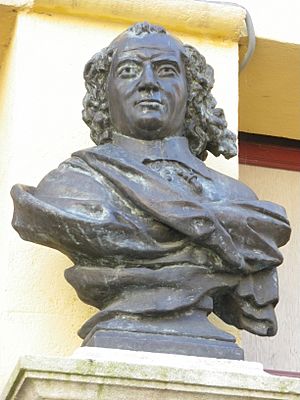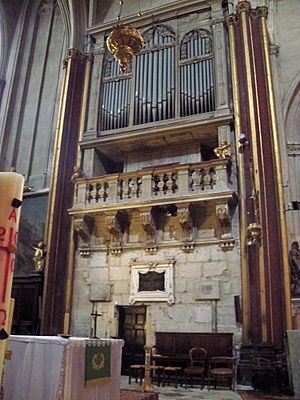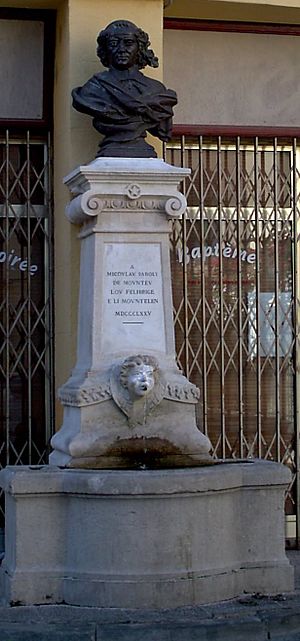Nicolas Saboly facts for kids
Quick facts for kids
Nicolas Saboly
|
|
|---|---|

Statue of Nicolas Saboly in Monteux, Vaucluse
|
|
| Born | 30 January 1614 Monteux, Vaucluse, France
|
| Died | 25 July 1675 (aged 61) Avignon, Vaucluse, France
|
| Nationality | French |
| Occupation | Poet, kapellmeister, composer |
| Known for | Occitan language carols |
Nicolas Saboly (born January 30, 1614 – died July 26, 1675) was a French poet, composer, and choirmaster. He is famous for writing many Christmas carols in the Provençal dialect. These carols are still loved and published today, showing how important his work was.
Contents
Early Life and Education
Nicolas Saboly was born on January 31, 1614, in Monteux, France. His family had a history of being herdsmen. Nicolas was the youngest of five children. His parents were Felisa Meilheuret and Jean Saboly.
Becoming a Priest
Nicolas's father passed away when Nicolas was only five years old. After this, Nicolas went to the Jesuit college in Carpentras. He later studied at the University of Avignon. He took classes in law and theology. In 1635, he became a priest.
Career as a Choirmaster
In 1639, Nicolas Saboly became the organist and choirmaster at the Saint-Siffrein Cathedral in Carpentras. He sometimes played the organ for local events. For example, he played for a church festival in Caromb and was paid for it. He left this job in 1643.
After Carpentras, Saboly worked as a choirmaster in other cities. He was in Arles from 1643 to 1646. Then he moved to the cathedral of Aix-en-Provence, where he worked from 1652 to 1655. He was also in Nîmes in 1659. Later, he became the choirmaster of the Saint-Pierre church in Avignon, where he stayed until he died.
Church Benefits
Like many priests of his time, Saboly received several church benefits. These were like special positions or payments. He became a chaplain in Carpentras in 1633. He also received a pension (a regular payment) from the church in 1660.
His Final Years
Nicolas Saboly wrote his will in 1671. He left most of his belongings to his niece, Claire Saboly. He also made sure that money was set aside for his servant and for masses to be said in his memory after he passed away.
He died four years later, on July 25, 1675, in Avignon. He was buried in the Saint-Pierre church. Nicolas Saboly's career as a choirmaster was typical for his time. However, he is most remembered for the beautiful Christmas carols he wrote.
His Works
Nicolas Saboly's most famous works are his Christmas carols. Many of them were published during his lifetime.
Manuscript Works
Some of Saboly's works exist as handwritten copies.
- The Bastide collection is a large collection of 220 carols. It includes music notes and is written in both Provençal and French.
- Other manuscripts contain some of his poems and even two polyphonic masses (music for multiple voices).
Printed Works
First Editions
Saboly's carols were first published in small booklets, called fascicles. These were released between 1668 and 1674. Some of the titles include:
- Lei Noé de San Pierre (The Christmas Carols of Saint Peter), published from 1668 to 1669.
- Histori de la naissenso dou fis de Diou (Story of the Birth of the Son of God), published in 1670.
- Noés nouveous (New Carols), published yearly from 1671 to 1674.
Collected Editions
Later, all of Saboly's carols were gathered and published in single books. These collections were very popular and were reprinted many times throughout the 18th and 19th centuries. Some editions even included the music notes for the carols.
Editions with Other Authors
In the 1800s, Saboly's carols were often published alongside carols by other famous Provençal writers like Antoine Peyrol and Joseph Roumanille. This showed how important Saboly's work was to the Félibrige literary movement, which aimed to protect and promote the Occitan language and culture.
List of Carols
Saboly did not write all the Christmas carols that people sometimes say he did. His carols were first published without music because they were meant to be sung to popular tunes that everyone already knew. Saboly would simply suggest a tune, like "on the air of the echo" or "on the air of the pastouro."
The Provencal Documentation Center has a list of 48 carols that are definitely by Saboly. Here are some of them, based on a famous 1856 edition:
First book (1667)
- Iéu ai vist lou Piemount
- Bon Diéu! la grand clarta
- Micoulau noste pastre
- Ai! quouro tournara lou tèms
- Li a proun de gènt que van en roumavage
- Un pau après lei tempouro
- Ça menen rejouissènço
- Viven urous e countènt
- Per noun langui long dou camin
- Ai! la bono fourtuno
- Pièisque l'ourguei de l'umano naturo
- Venès lèu vèire la pièucello
Second book (1668)
- Ai proun couneigu
- Chut! teisas-vous
- Ourguhious plen de magagno
- Diéu vous gard', noste mèstre
- Vers lou pourtau Sant-Laze
- Helas! qu'noun aurié pieta
Third book (1669)
- Li a quaucarèn que m'a fa pòu
- L'Ange qu'a pourta la nouvello
- Nàutre sian d'enfant de cor
- Tòni, Guihèn, Peiroun
- Un bèu matin, veguère uno accouchado
- Cerqués plus dins un marrit establo
Fourth book, titled "Story of the birth of Jesus Christ" (1670)
- Dòu tèms de l'empèri rouman
- Hòu! de l'oustau! mèstre, mestresso
- Lou queitivié d'aquéu marrit estable
- Sus lou coutau
- Lei pastourèu
- Soun tres ome fort sage
- Lei Mage dins Jerusalèn
- La fe coumando de crèire
Fifth book (1671)
- Lei plus sage - Dòu vesinage
- Lei pastre fan fèsto
- Sant Jòusè m'a dit
- Ben urouso la neissènço
- Aque ange qu'es vengu
- Despièi lou tèms
- Se vàutrei sias countènt
Sixth book (1672)
- Me siéu plega - E bèn amaga
- Que disès, mei bon fraire
- Jujas un pàu de quinto sorto
- Uno estello
- Quand la miejo-nue sounavo
- Un ange a fa la crido
Seventh book (1673)
- Pastre dei mountagno
- Lorsque vous sarés malaut
- Auprès d'aquel estable
- Adam e sa coumpagno
- Jèsu, vous sias tout fioc e flamo
- Pastre, pastresso
- Venès vèire dins l'estable
- Tu que cerques tei delice [sic]
- Vesès eici moun Nouvelisto
Eighth book (1674)
- Proufitas-me lèu, bravo bregado
- Touro-louro-louro! lou gau canto
- L'estrange deluge
- Vos-tu qu'anen en Betelèn
- Qu'vòu faire grand journado
- Segnour, n'es pas resounable
- Per vèire la jacènt
- Sortez d'ici, race maudite
Additions in the 1704 edition
- En sourtènt de l'estable
- Guihaume, Tòni, Pèire
- A la ciéuta de Betelèn
- Un ange dòu cèu es vengu
- Sus! campanié, revihas-vous
- Noun vous amusés en cansoun
Unpublished carols from the Bastide collection
- Fau que l'envejo me passe - De rire de tout moun sadou
- Vous tourmentès plus lou cervèu
- Desespièi l'aubo dòu jour - Iéu ause dire
- Iéu siéu Toumas, mai sariéu redicule
- La naturo e lou pecat - Soun pire que chin a cat
- Viras, viras de carriero - Bèu soulèu
Fragments from the Bastide collection
- Sian eici dous enfant de cor
- Bourtoumiéu, me vos-tu crèire?
- Enfin Diéu es vengu
- Se li a quaucun doute
- Bonjour, bonjour, bello bregado
- Un maset plen d'aragnado
- Quinto bugado - Avié fa noste paire Adam
Famous carols
- La marche des Rois (The March of the Kings)
- La Cambo me fai mau (My Leg Hurts)
- La Coupo Santo: This carol uses a tune from Saboly's "Guihaume, Tòni, Pèire." Frédéric Mistral later wrote new words to this tune, creating the Coupo Santo, which is now the anthem of Provence.
What People Thought of Saboly's Work
Many famous writers and scholars have praised Nicolas Saboly's carols:
- Frédéric Mistral said that for Provençal people, Saboly's carols are as important for Christmas as eggs are for Easter.
- J. B. Faury noted that you can only truly understand Saboly's carols if you sing them, because the words and music are so closely connected.
- Professor Charles Camproux from the University of Montpellier believed Saboly became a classic of Occitan literature. He said it's hard to find such perfect, yet simple, popular writing in other languages.
- Charles Rostaing and René Jouveau stated that Saboly had a big influence on later writers like Roumanille and Mistral.
- André Bouyala d'Arnaud, a librarian, mentioned that Saboly's work shows emotion, good humor, and even some playful political comments. He combined old traditions with the cleverness of writers like La Fontaine.



